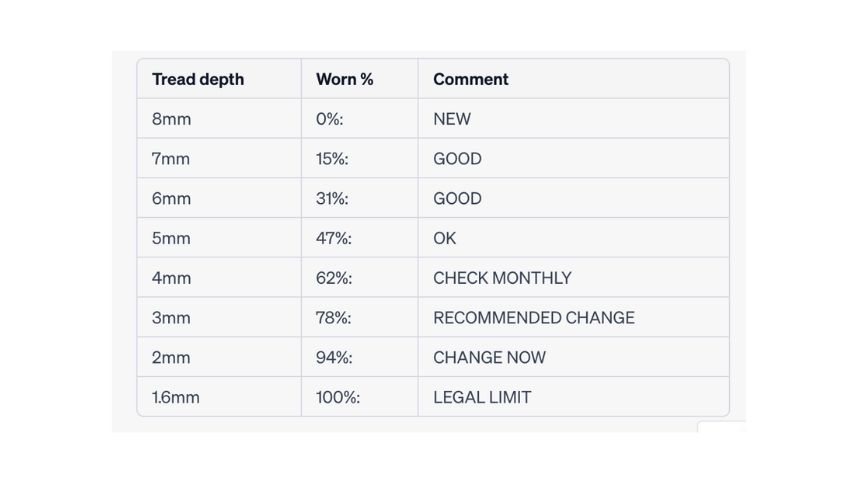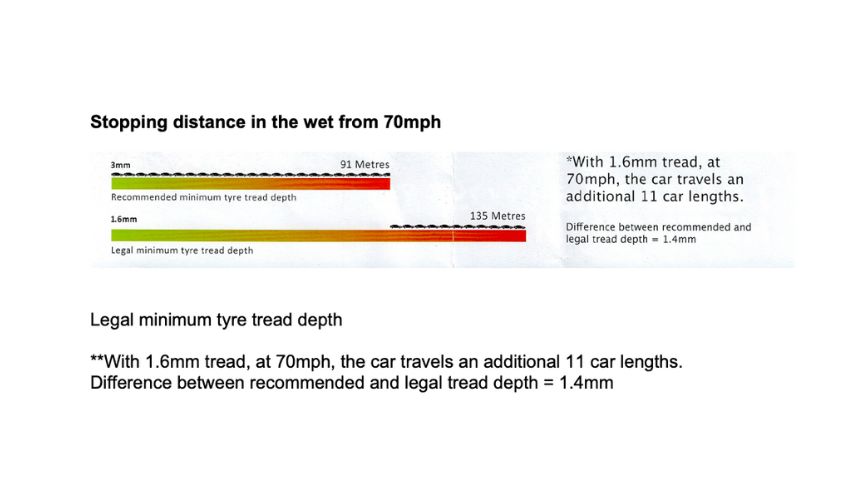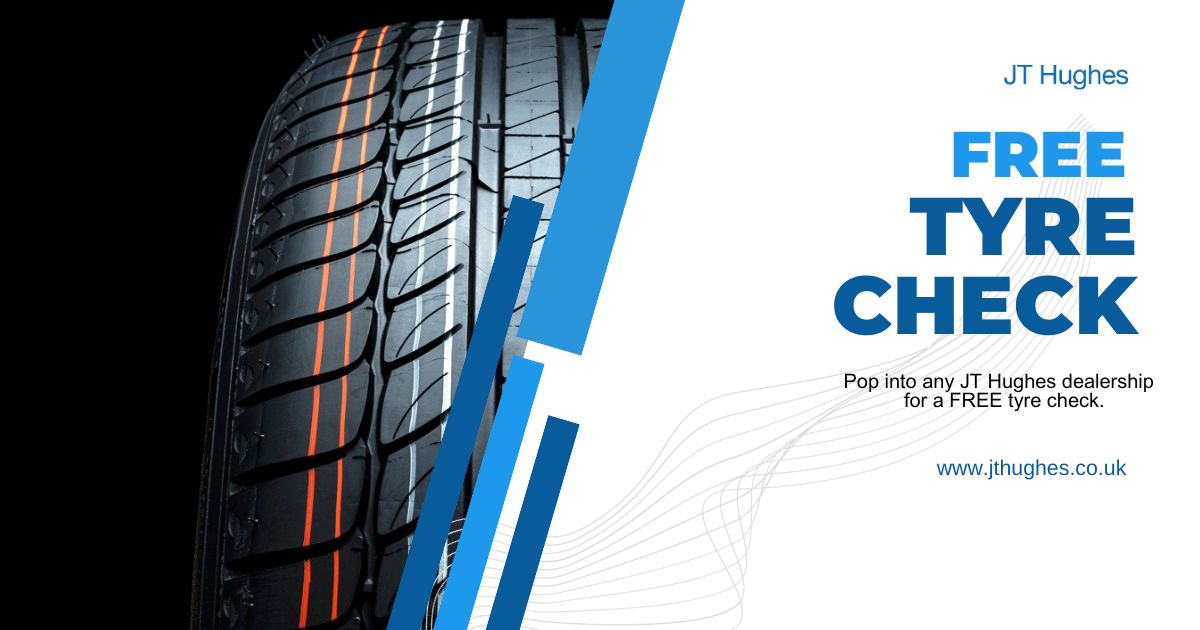https://www.jthughes.co.uk/Blog/View/How-Stopping-Distance-is-Affected-by-Tyres/12632
How Stopping Distance is Affected by Tyres

Ads by JT Hughes
Scroll to continue with content
Understanding Stopping Distance
To comprehend the relationship between tyres and stopping distance, it's essential to have a clear understanding of what stopping distance is and the various factors that affect it.
Worn tyres can increase your car’s stopping distance by up to 48%*
Checking your car tyres’ tread depths is child’s play.

We recommend tyres are replaced when 78% worn

What is Stopping Distance?
Stopping distance refers to the total distance a vehicle travels from the moment the driver applies the brakes until the vehicle comes to a complete stop.
It consists of two main components: thinking distance and braking distance.
Thinking distance is the distance covered while the driver reacts to a hazard and begins to apply the brakes.
It is influenced by factors such as the driver's reaction time, alertness, and the speed at which the vehicle is traveling.
Braking distance is the distance covered while the vehicle is decelerating under the effect of the brakes.
It is influenced by the efficiency of the braking system, road conditions, and the grip between the tyres and the road surface.
Factors Affecting Stopping Distance
Several factors can affect the overall stopping distance of a vehicle. These include:
-
Speed: The higher the speed, the longer the stopping distance. This is because it takes more time and distance to bring a fast-moving vehicle to a halt compared to a slower one.
-
Road Surface: Different road conditions, such as wet, icy, or uneven surfaces, can significantly impact stopping distance. Reduced traction on slippery roads increases the braking distance.
-
Vehicle Weight: Heavier vehicles require more force to stop, resulting in a longer braking distance compared to lighter vehicles.
-
Brake Efficiency: The condition of the braking system, including brake pads, discs, and hydraulics, can affect the efficiency of the brakes and, consequently, the stopping distance.
-
Tyre Condition: The condition of the tyres plays a vital role in stopping distance. Factors such as tyre tread depth, grip, traction, and tyre pressure can impact braking performance. For more information on the relationship between tyre condition and stopping distance, refer to our article on braking distance and tyre performance.
Understanding these factors is crucial in comprehending how tyres can affect stopping distance.
In the subsequent sections, we will explore the specific role that tyres play in determining the distance it takes for a vehicle to come to a stop.

The Role of Tyres in Stopping Distance
When it comes to stopping distance, the condition of your tyres plays a crucial role.
The following factors related to tyres can significantly impact stopping distance: tyre tread depth, tyre grip and traction, and tyre pressure.
Tyre Tread Depth
Tyre tread depth is an important aspect to consider when it comes to stopping distance.
The tread of a tyre refers to the pattern on its surface that helps to channel water away and maintain grip on the road.
Over time, the tread depth gradually wears down due to regular use.
A tyre with insufficient tread depth can have a negative impact on stopping distance, especially on wet surfaces.
As the tread wears down, the tyre becomes less effective at dispersing water, increasing the risk of hydroplaning and reducing overall traction.
It is recommended to regularly check your tyres' tread depth and ensure that they meet the legal requirements.
For more information on factors affecting stopping distance, refer to our article on factors affecting stopping distance.
Tyre Grip and Traction
The grip and traction of your tyres are vital for maintaining control and reducing stopping distance.
Tyres with good grip provide better traction, allowing for quicker and more efficient braking.
Factors such as the tyre compound and the design of the tread pattern can influence the grip and traction of a tyre.
In wet conditions, tyres with improved grip can help reduce the risk of skidding and improve overall braking performance.
It's important to choose tyres that are specifically designed for wet road conditions to enhance safety.
For more information on the relationship between tyre grip and stopping distance, refer to our article on tyre grip and stopping distance.
Tyre Pressure
Maintaining the correct tyre pressure is essential for optimal stopping distance. Underinflated or overinflated tyres can negatively affect braking performance.
Underinflated tyres can lead to increased rolling resistance, reduced grip, and longer stopping distances.
On the other hand, overinflated tyres can result in a reduced contact patch, leading to decreased traction and compromised braking efficiency.
Regularly checking and maintaining the recommended tyre pressure ensures that your tyres are operating at their best.
Refer to your vehicle's manual or the tyre manufacturer's guidelines for the correct tyre pressure.
For more information on the impact of tyre pressure on stopping distance, check out our article on tyre pressure and stopping distance.
By understanding and taking into account the role of tyres in stopping distance, you can ensure that your vehicle is equipped with the right tyres and properly maintained for optimal braking performance.
Remember to regularly monitor your tyre tread depth, choose tyres with good grip and traction, and maintain the recommended tyre pressure.
These simple measures can significantly contribute to safer driving conditions and reduced stopping distances.
How Tyres Impact Stopping Distance
When it comes to stopping distance, the condition of your tyres plays a crucial role.
Different road conditions and the quality of your tyres can significantly affect how quickly your vehicle comes to a halt.
Let's take a closer look at how tyres impact stopping distance, specifically in wet road conditions, dry road conditions, and braking efficiency.
Wet Road Conditions
On wet roads, the risk of skidding and losing control of your vehicle increases.
This is where the condition of your tyres becomes even more important.
Tyres with good tread depth and proper grip can disperse water effectively, reducing the chances of hydroplaning and improving braking performance.
In wet conditions, the tread pattern on your tyres helps to channel water away from the contact patch between the tyre and the road.
This allows the tyre to maintain better traction, resulting in shorter stopping distances.
Make sure to regularly check the tread depth of your tyres to ensure they meet the legal requirements.
For more information on how tyre tread depth affects stopping distance, refer to our article on braking distance and tyre tread.
Dry Road Conditions
While wet conditions pose their own challenges, dry road conditions also require proper tyre performance for optimal stopping distances.
Tyres with good grip and traction can provide maximum contact with the road surface, allowing for better braking efficiency.
In dry conditions, tyres with a softer compound and a larger contact patch tend to offer improved grip.
This results in shorter stopping distances as the tyres can effectively grip the road surface and bring the vehicle to a halt more efficiently.
Remember to choose tyres that are suitable for your driving needs and the prevailing weather conditions in your area.
For more information on how tyre grip affects stopping distance, refer to our article on tyre grip and stopping distance.
Braking Efficiency
Apart from road conditions, the overall braking efficiency of your vehicle is influenced by the quality and condition of your tyres.
Tyres with proper inflation and optimal tyre pressure allow for better contact between the tyre and the road, resulting in improved braking performance.
Underinflated or overinflated tyres can negatively affect braking distance. Underinflated tyres increase rolling resistance and may cause the tyres to deform, reducing traction and compromising braking efficiency.
On the other hand, overinflated tyres may reduce the contact patch, leading to decreased grip on the road surface.
Regularly monitoring and maintaining the proper tyre pressure can ensure that your tyres perform optimally, contributing to shorter stopping distances.
For more information on how tyre pressure affects stopping distance, refer to our article on tyre pressure and stopping distance.
By understanding how tyres impact stopping distance in wet and dry road conditions, as well as the importance of braking efficiency, you can make informed decisions about the tyres you choose and ensure their proper maintenance.
Remember to consult with a professional for specific tyre recommendations based on your vehicle and driving needs.
The Importance of Regular Tyre Maintenance
To ensure optimal safety on the road and minimise stopping distance, regular maintenance of your tyres is essential.
By regularly checking the tyre tread depth, monitoring tyre pressure, and replacing worn-out tyres, you can significantly improve your vehicle's braking performance.
Checking Tyre Tread Depth
The tyre tread depth plays a crucial role in maintaining traction and grip on the road, especially in wet conditions.
As the tread wears down over time, it becomes less effective at dispersing water and maintaining contact with the road surface.
This can result in longer stopping distances and an increased risk of skidding.
To check the tread depth, you can use a tread depth gauge or the simple "20p test". Place a 20p coin into the main grooves of the tyre.
If the outer band of the coin is visible, it may be time to replace the tyres.
For more information on factors affecting stopping distance, visit our article on factors affecting stopping distance.
Monitoring Tyre Pressure
Proper tyre pressure is crucial for maintaining optimal braking performance and reducing stopping distance.
Underinflated tyres can lead to increased rolling resistance and compromised handling, while overinflated tyres can reduce the contact patch with the road, resulting in reduced grip.
Regularly check the tyre pressure using a reliable pressure gauge and ensure it matches the recommended levels specified by the vehicle manufacturer.
Refer to your vehicle's manual or the sticker located on the driver's side door jamb for the recommended tyre pressure.
For more information on the relationship between tyre pressure and stopping distance, refer to our article on tyre pressure and stopping distance.
Replacing Worn-out Tyres
Worn-out or bald tyres can significantly compromise your vehicle's ability to stop safely.
As the tyre tread wears down, it loses its ability to provide adequate traction, especially on wet or slippery surfaces.
This can result in longer stopping distances and an increased risk of hydroplaning.
Regularly inspect your tyres for signs of wear or damage, such as uneven tread wear, cracks, or bulges.
If the tread depth indicators are flush with the surface of the tyre, it's a clear indication that the tyres have reached the legal limit and should be replaced.
For more information on the relationship between tyre tread and stopping distance, refer to our article on braking distance and tyre tread.
By regularly checking the tyre tread depth, monitoring tyre pressure, and promptly replacing worn-out tyres, you can ensure optimal braking performance and reduce the risk of accidents on the road.
Remember, your tyres are the only contact point between your vehicle and the road, so prioritising their maintenance is crucial for your safety.
Tips for Improving Stopping Distance
When it comes to ensuring your safety on the road, understanding how to improve stopping distance is crucial.
While various factors play a role in stopping distance, such as road conditions and braking efficiency, the condition of your tyres is paramount.
Here are some tips to help you improve your stopping distance by choosing the right tyres, maintaining optimal tyre condition, and adjusting your driving style for road conditions.
Choosing the Right Tyres
Selecting the appropriate tyres for your vehicle is essential for optimal stopping distance. Consider the following factors when choosing tyres:
-
Tyre Tread Depth: Adequate tyre tread depth is crucial for maintaining grip and traction on the road. The legal minimum tread depth in the UK is 1.6mm across the central three-quarters of the tyre. However, for improved safety, it is recommended to replace tyres when the tread depth reaches 3mm. Check out our article on braking distance and tyre tread for more information.
-
Tyre Grip and Traction: Look for tyres with good grip and traction properties, especially in wet road conditions. Tyres with high-performance ratings in terms of wet grip can significantly improve your stopping distance. Refer to our article on tyre grip and stopping distance for further insights.
-
Tyre Pressure: Maintaining the correct tyre pressure is crucial for optimal braking performance. Underinflated or overinflated tyres can negatively impact stopping distance. Regularly monitor and maintain the recommended tyre pressure, as specified by the vehicle manufacturer, to ensure safety. Learn more about the relationship between tyre pressure and stopping distance in our article on tyre pressure and stopping distance.
Maintaining Optimal Tyre Condition
Proper maintenance of your tyres is essential for ensuring optimal stopping distance.
Follow these tips to keep your tyres in top condition:
-
Checking Tyre Tread Depth: Regularly inspect the tread depth of your tyres to ensure they meet the legal requirements. Use a tread depth gauge or the '20p coin test' to assess the tyre tread depth. If the tread depth is below the recommended level, consider replacing the tyres as soon as possible.
-
Monitoring Tyre Pressure: Check your tyre pressure at least once a month and before long journeys. Use a reliable pressure gauge to measure the pressure and adjust it to the recommended level. Remember to check the pressure when the tyres are cold for accurate readings.
-
Replacing Worn-out Tyres: It is crucial to replace worn-out tyres promptly. As tyres age and wear down, their ability to grip the road surface diminishes, which can significantly impact stopping distance. Regularly inspect your tyres for signs of wear, such as cracks, bulges, or uneven tread wear. If you notice any issues, consult a professional and consider replacing the tyres.
Adjusting Driving Style for Road Conditions
In addition to tyre maintenance, adjusting your driving style according to road conditions is vital for improving stopping distance.
Consider the following tips:
-
Reduce Speed: Adhere to speed limits and adjust your speed based on the road conditions. Slowing down allows for better control and a shorter stopping distance, particularly in adverse weather conditions.
-
Increase Following Distance: Maintain a safe following distance between your vehicle and the one ahead. This gives you more time to react and allows for a greater stopping distance if needed.
-
Anticipate and Brake Early: Be proactive and anticipate potential hazards on the road. Brake early and gradually to avoid sudden stops, which can increase stopping distance and potentially lead to skidding.
By following these tips, you can improve your stopping distance and enhance overall road safety. Remember to prioritise regular tyre maintenance, choose the right tyres for your vehicle, and adjust your driving style to suit the road conditions. Safe driving starts with attention to detail and proactive measures to ensure your tyres are in optimal condition.